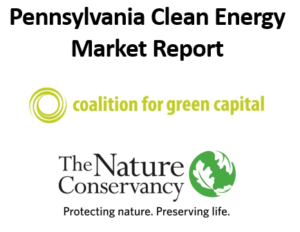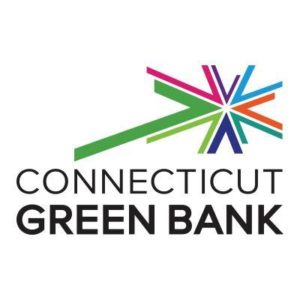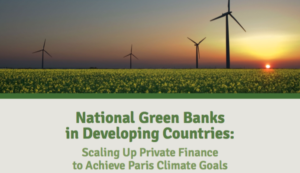The Clean Energy Future Blog
By Coalition for Green Capital

CGC, along with our partner The Nature Conservancy (TNC), is delighted to announce the release of its new reports: the Pennsylvania Clean Energy Market Report and the Pennsylvania Energy Investment Partnership Report.
The first report is an analysis of the Pennsylvania clean energy market landscape. It estimates that there is a largely untapped market potential of approximately $16 – $20 billion in economically viable clean energy projects throughout Pennsylvania. The report also finds some of the challenges facing the clean energy market in Pennsylvania include: constrained and disaggregated sources of capital for clean energy projects, information gaps and limited uptake of program resources, and few financial products that target a single market segment, among others.
This report is the first of its kind in Pennsylvania—it includes a comprehensive clean energy market landscape assessment. The institutions, programs, policies, laws and incentives that shape the clean energy market in Pennsylvania are discussed in detail. This report also includes information on the clean energy market activity to date, as well as estimates of clean energy market potential drawn from a variety of sources across a handful of specific technologies. As a part of this work, CGC interviewed more than 40 people and organizations, including project developers, contractors, investors, policymakers, NGOs, program managers, government officials, and regulators.
The second report outlines how a Green Bank, or “Energy Investment Partnership,” could facilitate increased clean energy penetration in the Pennsylvania market. The report includes options for financing structures, institutions, products, and activities tailored to fit Pennsylvania that could help fill market gaps and spur more clean energy deployment.


TNC sees the sustainable and efficient use of energy and the deployment of appropriately-sited clean energy resources are critical to the organization’s conservation mission. CGC began working in partnership with the Pennsylvania Chapter of TNC in 2015 to produce a clean energy market report and investigate possible Green Bank solutions in Pennsylvania. More information is available at TNC’s website.
Sparking the Green Bank Movement
By Coalition for Green Capital

Today the Connecticut Green Bank won the prestigious Innovations in American Government Award for 2017. Given annually by the Harvard Kennedy School’s Ash Center for Democratic Governance, today’s ceremony acknowledges what those in the Green Bank and clean energy finance world have seen for years – that Connecticut Green Bank sparked a Green Bank movement. The Connecticut Green Bank now joins an impressive list of past winners, all of whom have demonstrated how creative policy, partnerships and focus can create large-scale change from the status quo.
And that kind of change is exactly what is needed today to address climate change. Each new policy, regulation and government approach to reduce GHGs is a move in the right direction. But the significant change – which moves our communities onto an entirely different emissions pathway – will only come with a dramatic departure from business-as-usual. The global projected climate investment gap is $27 trillion. There is no way to fill this gap without innovative new government approaches that reorient capital and energy markets in a new direction.
And as the Connecticut Green Bank has proven, dramatic departure from business as usual can be a win-win-win for government, energy-users, and the private sector. Government capital is preserved through financing, energy customers get cheaper and cleaner energy, and the private sector can move into new market opportunities. Successful innovations are better, cheaper, or faster, the Connecticut Green Bank has found a way to deliver on all three.
The Connecticut Green Bank just cleared $100M in commercial building upgrades with C-PACE. Through its partnership with Posigen, over 1,000 CT low-to-moderate income households have lower their energy costs through solar and efficiency. Innovative new clean energy technologies are being deployed. All while maximizing the value of the public dollar. And, to its, credit, the Green Bank has worked hard to be complementary and additive to the existing programs, enabling all government programs to shine.
The value brought to Connecticut citizens is clear, but the real power of this innovation comes from replication. New York’s Green Bank is now profitable. The District of Columbia has legislation to create the first U.S. city Green Bank. Nevada is taking its own approach to the Green Bank model. And it’s not just a U.S. movement. Ontario is capitalizing its new deployment and finance organization with cap-and-trade auction revenues. And CGC’s recent work on developing countries found surging interest in the model.
This is the power of market-oriented government innovation. If harnessed, studied, and spread through thoughtful networks and collaboration, it can catch on like wildfire. That is why CGC is excited to renew its partnership with the Connecticut Green Bank and others around the Green Bank Academy. First offered as a conference for state leaders in 2014, in partnership with the Brookings Institution, the Green Bank Academy will now be relaunched as a dedicated platform. It will educate and train policymakers, practitioners and students, building the necessary pipeline of leaders to expand the Green Bank movement and build new institutions. CGC and the Connecticut Green Bank will build on its existing partnership with Yale’s Center for Business and the Environment, which is already producing case studies.
Today’s award celebrates the Connecticut Green Bank’s past success to spark the Green Bank movement. The goal of the Green Bank Academy is to carry that movement forward, and rapidly expand it throughout the U.S. and the world.
By Coalition for Green Capital


The Coalition for Green Capital (CGC), with support from the Hewlett Foundation, has published a new paper exploring how the Green Bank model can be implemented in emerging markets to help achieve national climate goals. The paper examines how Green Banks (either purpose-built entities or adaptations of existing institutions) can be effective in channeling investment from carbon to clean in emerging economies and in driving global clean energy investment to the scale required to achieve international climate goals.
With the Paris agreement in place, the burden of climate action has shifted from international discussion to nation-specific implementation. And with that shift it becomes clear that far more investment, primarily from the private sector, will be needed to meet local climate goals and Nationally Determined Contributions (NDCs). Existing climate policies and investment pledges are projected to yield far less global climate investment than what is needed to keep temperature rise below two degrees Celsius. There is a $27 trillion investment shortfall that must be filled. New approaches are needed to drive private investment at unprecedented scale, and quickly. An additional hurdle is that investments must offer attractive returns while also delivering affordable clean energy solutions to customers. This challenge is particularly acute in developing economies where issues of energy access and affordability are central to the clean energy transition.
National Green Banks – structured as either new purpose-built institutions or adaptations of existing institutions – can be developed around the world to address critical market gaps and drive public and private climate investment. Green Banks are public-purpose finance institutions dedicated to green investment, embodying the pure focus and local market-oriented approach needed to fill the investment shortfall. In multiple countries, Green Banks have successfully driven investment into clean energy infrastructure in their local markets. Green Banks are designed to maximize total investment, using limited public funds to leverage far greater private investment. By developing innovative finance and market development solutions, Green Banks address barriers that currently restrict clean energy market growth.
Since initiating work on this scoping effort in January 2017, interest in the Green Bank model has grown and is seeing increased visibility as a promising option for expanding the climate finance architecture in developing countries. A promising cohort of countries is emerging as an early proof-of-concept opportunity for the Green Bank model including South Africa, Mexico, Chile, India, Morocco, the Philippines, Colombia, and others.
“To achieve zero net greenhouse emissions globally by the end of this century, governments need to make full use of their capacity to leverage and unlock much larger flows of private investment in low-carbon infrastructure. Public green investment banks can help accelerate the shift to low-carbon investment at the national and sub-national levels.”
– Angel Gurría, OECD Secretary-General
CGC recognizes that creating a replicable Green Bank model for scaling up climate will require the combined efforts of a consortium of expert organizations. We are working to develop a collaborative framework to support the design and capitalization of 4-6 institutions that can be operational by approximately 2020 and serve as models for replication by others. Initial non-profits and intergovernmental organizations involved in this collaborative effort include the Coalition for Green Capital (CGC), Rocky Mountain Institute (RMI), Natural Resources Defense Council (NRDC), Climate Policy Initiative (CPI), and the Organization for Economic Cooperation and Development (OECD) and are joined by several partners from the for-profit consulting community (Climate Finance Advisors and Rick Nogueira).
“National green investment banks (GIBs) offer a replicable model for moving the locus of problem-solving and agency to the national level, empowering developing countries to benefit from international financial resources while also better attracting private capital. This model can serve as the centerpiece of a radically more efficient and effective climate finance architecture that enables the fulfillment of ambitious Nationally Determined Contributions (NDCs).”
–Paul Bodnar, Managing Director, Rocky Mountain Institute
To inform our work, CGC conducted a series of interviews and a stakeholder work-session with more than 100 representatives of development financial institutions, national development banks, developing country representatives, existing Green Banks, capital providers, climate funds, thought leaders, government officials and others from the climate finance community. We also worked closely with a core group of expert organizational partners to help inform and shape our recommendations on application of the Green Bank model.
Bill Would Create DC Green Bank
By Coalition for Green Capital
The mayor of District of Columbia, Muriel Bowser, recently introduced legislation that would establish Green Bank for the District. The bill would create the “Green Finance Authority” as an instrumentality of the DC government to finance and promote the deployment of clean energy technology within the District. The Green Finance Authority will act as the DC Green Bank, and will offer a range of financing tools and programs to catalyze investment in clean energy. The Green Finance Authority will have separate legal existence from the DC government, and will not offer the full faith and credit of the DC government.
A Green Bank could change the game in the District of Columbia
This bill is the culmination of a multi-year Green Bank effort in DC. In June of 2015, the Coalition for Green Capital (CGC) signed a contract with the District of Columbia Department of Energy and the Environment (DOEE) to complete a study of a DC Green Bank. To complete the analysis, CGC worked in partnership with the DOEE and a large group of District stakeholders, including meetings and phone calls with policymakers, program administrators, clean energy advocates, lenders, contractors, and others to understand the clean energy landscape in the District.
CGC’s Green Bank study was published in April 2017 and concluded there was a very strong case for a Green Bank in the District of Columbia. The District has more than $3 billion clean energy project potential. The study estimated that over $1.4 billion of economically viable energy efficiency investments could be made in District buildings, and that up to $1 billion or more in investment in solar will be necessary for the District to meet the solar requirement in its renewable portfolio standard. The District of Columbia imports nearly all of its electricity, creating an enormous opportunity for DC to keep energy dollars in the state by investing in in-District energy resources. These conditions suggest that a Green Bank could dramatically improve the prospects for distributed clean energy technology in DC. As stated in the report:
The District has a clear and pressing need to stimulate more private investment in its clean energy economy to reach its climate and energy goals. … The District should establish a Green Bank, capitalized with public dollars, to leverage private investment, drive demand and increase access to clean energy. In combination with existing programs, the Green Bank can help District residents and businesses enjoy cleaner and cheaper energy.
DC is newest member of growing Green Bank movement
Through our work across the country and abroad, CGC is seeing snowballing interest in creating Green Banks as a tool for catalyzing more clean energy investment. Beyond the Green Bank activity in the District, there are efforts to create new Green Banks (at various stages of development) in Nevada, Ontario (province), Canada (federal government), South Africa, and Montgomery County Maryland. This growing interest is not surprising. At the end of 2016, US Green Banks had participated in over of $2 billion of clean energy transactions. And globally, Green Banks have already supported investments of $25.9 billion, using only $7.9 billion of their own capital!
With the bill in committee now, the next step is for the members to pass the bill into law. If DC Council passes the bill, the District would join states such as Connecticut, New York, and Rhode Island in having a Green Bank. Green Banks do not depend on federal policies to have a positive impact on local jobs and energy markets—Green Banks represent an important way for states and other sub-national governments to make an impact on emissions in the absence of federal leadership.
Resources:
By Coalition for Green Capital
Today, Representative Elizabeth Esty (D-CT) and Senator Chris Murphy (D-CT), with co-sponsors from across the country, introduced H.R. 2995 and S. 1406, the Green Bank Act of 2017. This bill creates a United States Green Bank that will support the creation of a 21st century American energy infrastructure by providing a comprehensive range of financing—including loans, loan guarantees and other forms of risk mitigation—on a competitive basis to local Green Banks. The United States Green Bank would solely be a pass-through for allocating funding to qualified institutions, meaning authority over project selection and management would remain with local Green Banks. The United States Green Bank would have an initial capitalization of $10 billion, and a maximum capitalization of $50 billion.
Demand for regional, state, and local Green Banks is high due to the success of early Green Banks such as the Connecticut Green Bank, which has used under $200 million in ratepayer funds to cause over $1 billion in investment in Connecticut’s clean energy and energy efficiency markets in the five years since its creation. State and local Green Banks are operating across the country, and many more Green Banks are in various stages of development. Governor Brian Sandoval (R-NV) became the most recent leader to sign Green Bank legislation in Nevada.
As the nation’s energy generation, transmission, and distribution infrastructure continue to evolve, the United States Green Bank would provide the support necessary for specific areas of the country to address energy infrastructure issues that are most relevant to that region, state, or locality. This could be a transmission project to bring clean energy from remote areas to load centers, accelerating the adoption of distributed energy generation projects in a targeted area, or financing innovative and market-ready technologies such as energy storage.
Green Banks exist to fill financing gaps in clean energy and energy efficiency markets wherever they exist and to use taxpayer and ratepayer dollars more efficiently, getting more bang for every public buck that is used to create a 21st century energy American infrastructure. The possibilities for the application of these funds are wide-ranging, and by working exclusively through regional, state, and local Green Banks, a United States Green Bank will allow for a tailored regional approach to addressing gaps in the market, instead of trying to force a one size fits all approach across the country. Existing Green Banks will be boosted by an infusion of new capital, new Green Banks can be created to address local market issues, and a the United States Green Bank will power the transition to a 21st century American energy infrastructure.
Previous iterations of the Green Bank Act were introduced in 2016 and 2014.
Nevada Governor Signs Green Bank Bill
By Coalition for Green Capital
 This week, Nevada Governor Brian Sandoval (R) signed a bill establishing a Nevada Green Bank into law. The bill directs the Nevada Governor’s Office of Energy to create an independent, nonprofit corporation named “the Nevada Clean Energy Fund.” The Nevada Clean Energy Fund purpose will be to support the deployment of clean energy technologies in the state. To accomplish this goal, the Clean Energy Fund will offer a range of financing structures, forms, and techniques for clean energy projects.
This week, Nevada Governor Brian Sandoval (R) signed a bill establishing a Nevada Green Bank into law. The bill directs the Nevada Governor’s Office of Energy to create an independent, nonprofit corporation named “the Nevada Clean Energy Fund.” The Nevada Clean Energy Fund purpose will be to support the deployment of clean energy technologies in the state. To accomplish this goal, the Clean Energy Fund will offer a range of financing structures, forms, and techniques for clean energy projects.
A Green Bank is an enormous opportunity for Nevada
This bill is the culmination of a multi-year Green Bank effort in Nevada. During the 2015 legislative session, State Senator Pat Spearman sponsored legislation that directed the Interim Legislative Committee on Energy to complete a study of a Nevada Green Bank. The Coalition for Green Capital (CGC) immediately stepped in to offer support on executing the study, working in partnership with the Governor’s Office of Energy to complete the analysis. Over the course of eight months, CGC met in person and by phone with policymakers, clean energy advocates, the regulator, installers and others to understand the clean energy landscape in Nevada.
The study found there was a compelling case for a Green Bank in Nevada. Distributed technologies, like rooftop solar and efficiency, represented at least a $3.5 billion investment opportunity in Nevada. Roughly 90% of Nevada energy is imported, creating an enormous opportunity for Nevada to retain a greater number of energy dollars spent in the state by investing in in-state energy resources. Nevada residents are paying some of the highest electricity prices in the Mountain West. These facts point towards the need for a Green Bank. As stated in the report:
Green Bank investments would increase the state GDP, create new businesses, lower energy costs, and create new jobs. The Connecticut Green Bank, serving a market similar in size to Nevada, has generated almost a $1 billion of total clean energy investment in five years of activity.
The study included interviews with over 50 Nevada stakeholders, who expressed enthusiasm for a dedicated clean energy finance institution in Nevada. Stakeholders noted the difficulty of accessing financing at attractive rates and the decline in energy rebates as key challenges holding back the growth of clean energy markets.
Nonprofit Green Bank model growing more popular
The study recommended that the state create a nonprofit corporation to serve as the state Green Bank, which was the path ultimately selected in the legislation. Through our work across the country, CGC is seeing growing interest in the model of creating Green Banks as independent nonprofits rather than governmental institutions. In addition to Nevada, Montgomery County, Maryland also opted for a nonprofit approach for its county-level Green Bank. While there is no “right” way to create a Green Bank, state and local governments may opt for a nonprofit model to accelerate institutional formation and open the door to more diverse capitalization sources, such as philanthropy.
With the bill now signed, the next step is the actual formation of the institution. CGC looks forward to continuing our engagement in Nevada and supporting in-state partners as the formation process gets underway.
Nevada’s entrance onto the Green Bank scene is the latest indication that the Green Bank movement is picking up steam. Nevada joins states such as Connecticut, New York, and Rhode Island in establishing state-level Green Banks. Earlier this year, the mayor of DC announced her intention to form a Green Bank. At the end of last year, US Green Banks had participated in over of $2 billion of clean energy transactions. Expert observers have noted that demand for state and local Green Banks may accelerate in reaction to the US withdrawal from the Paris Agreement, as leaders pursue alternative pathways to lowering emissions. Green Banks are particularly attractive for policymakers because they do not depend on federal policies to have a positive impact on local jobs and energy markets.
Resources:
Follow
The Clean Energy Future Blog
for links, analysis, and commentary on the world of green banks and clean energy investment
